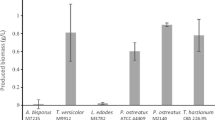Several yeasts were isolated from a drainage canal in a Japanese fish food processing factory. They were characterized by the decomposition of organic polymers such as proteins and reducing sugars, their growth in the wastewater, the decrease in total organic carbon (TOC), and taxonomy. Three strains of yeast dominated the sample: Debaryomyces occidentalis (P1), Trichosporon ovoides (P19), and a strain that could not be identified (S27). Strain P19 had the highest TOC-decreasing activity and was immobilized onto chitosan beads. The immobilized yeasts reduced the TOC from 1.2 × 103 to 3.0 × 102 mg of C/L per day in the fish cannery wastewater.
Similar content being viewed by others
Author information
Authors and Affiliations
Rights and permissions
About this article
Cite this article
Urano, N., Sasaki, E., Ueno, R. et al. Bioremediation of Fish Cannery Wastewater with Yeasts Isolated from a Drainage Canal . Mar. Biotechnol. 4, 559–564 (2002). https://doi.org/10.1007/s10126-002-0045-6
Received:
Accepted:
Issue Date:
DOI: https://doi.org/10.1007/s10126-002-0045-6




